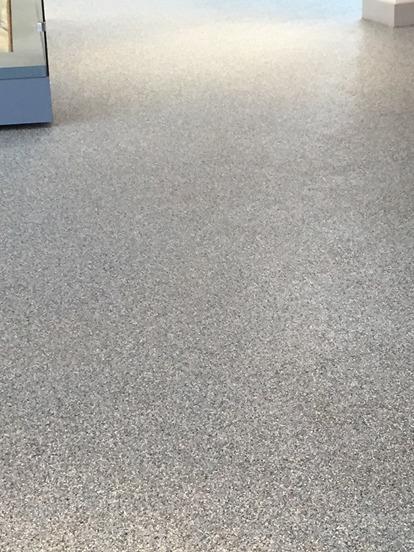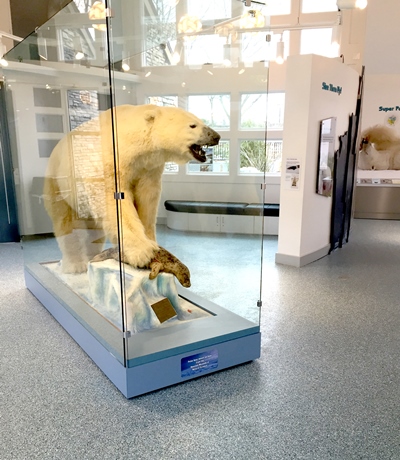Coatings contracting firm Patterson-Stevens and its eight-person crew were the super heroes on a recent renovation at the Buffalo Zoo. The X-shaped building is the former site of the zoo’s gift shop, but it has been renewed as an arctic exhibit.
Before visitors could buy tickets to the new display, though, the Patterson-Stevens crew needed to deal with unexpected moisture in the concrete slab. Polar bears may prefer rivers but coatings contractors surely do not!
Finding the Drive
The coatings crew found water during the preconstruction phase of the 2,500-square-foot (232.3 m²) project. They discovered moisture drive on the 6-inch (15.2 cm) slab. “Most coating manufacturers require less than 5 percent on a moisture meter, and it was showing — even though it was an old existing concrete slab — there was definitely moisture in the floor,” explained Nicholas White, project manager for Patterson-Stevens. His take was that it was just the “nature” of curing concrete, but regardless, a moisture-blocking primer would have to be included in the system. “The AquaFin SG3 needed to be added below the system to take care of that issue,” he said of the moisture-blocking primer.
To set the system up for success, the crew first had to hit the surface prep. They used BlastPro BP9SP shot blasters with an Ermator S36 vacuum with steel shot to achieve International Concrete Repair Institute’s concrete surface profile (CSP) 3‒4. “That way you get a good bond for the coating to the floor,” said White. They also used 7-inch (17.8 cm) grinders from Hilti, again with vacuums attached. “And we buzz those around all the perimeters,” White continued.
The crew smoothed over any joints with an epoxy joint filler and taped up drains and the perimeter of the building before laying down the VAPORTIGHT COAT-AquaFin SG3, which was applied at 16‒20 mils (406.4‒508.0 microns). “You just kind of flood the area and let it get hard,” said White.
Consistency Is Key
As it turned out, the shape of the building was one of the crew’s biggest challenges, especially when applying the next layer: the NEOCRETE SL.
“The key to when you put it down is you gotta maintain that wet edge,” White said. “Given the shape of the building, we really had to work hard to maintain that edge because…it wasn’t a typical square building where you can just start in the corner and kind of work side to side and work your way back to the door.”
Their strategy was more involved: “We kind of had to work both portions of the X from the top and work our way to the middle, and then work our way into the other two corners of the X and out the door ‘cause we had one door that we were working out of,” White explained. “The keys to that are constantly mixing and providing your guys with enough material so they can just get it down, gage rake it, spike roll it, and throw the flake into it before the stuff sets up. That was truly the key to the process: Just feeding our guys constantly as we were doing it.”

And one guy had top billing. As White said, “I would say in the whole operation, other than the guy overseeing that the right millage is down per coat before you walk away from it, the mix guy is the most important person in the whole process.” That guy had to mix each component for a specific amount of time — and do it consistently throughout the job.
Having a consistent mixer or at least a consistent process (aka “making sure you’re even across the board,” according to White, with all parts even when being relieved for a few minutes) is crucial to avoiding an incorrect mix and a messed up floor.
It was also up to the mix guy to make sure the powder didn’t clump. But it was up to White to give the crew what it needed. According to him, that was “the biggest thing from a project manager standpoint.” He continued, “And if something were to come up, if they had a mixing drill go down in the middle of mixing, it’s things like that where we say, ‘hey, have an extra one in the truck or have an extra one next to you in case that goes down,’ that way you’re still able to mix.”
White was also sure to have extra rollers, rakes, and spike shoes for the other members of the crew “just in case something happens,” he said. “That’s truly the only thing you can do to prep yourself, other than having enough guys who’ve been doing it as long as they have been doing this type of work.” To that end, all roller covers, frames, and poles came from a local supplier called Young and Swartz.
Can’t Coat!
Patterson-Stevens makes it a common practice to try to be the last contractor on the job “prior to the furniture,” according to White. That way, there’s a smaller chance that any other trades on the project, such as the wall painters, would damage the newly finished floor. According to White, scissor lifts, for example, could cause grooves or scratches.
Therefore, after the floor was down, it was up to the general contractor, Pike Company, to keep it up to snuff. “So we tell them ‘this is yours now, and just protect it if you’re going to bring anything heavy or potentially harmful on it.’”
 Even with a well-planned project, though, some things were just out of the crew’s hands. When it was finally time to install the workhorse coating, Mother Nature had a different idea.
Even with a well-planned project, though, some things were just out of the crew’s hands. When it was finally time to install the workhorse coating, Mother Nature had a different idea.
The cementitious urethane included three parts, one of which was a powder, and their mixing station was outside the building. “There was no mud room, there were no entrances or walkways that were covered outside,” White explained. There was no way they could coat. “It was raining on Friday, and I told the general contractor, ‘Hey, I can’t work today because I have powder, the powder can’t get wet. I can’t coat today.’”
White offered to have the crew return to coat on Monday, but there was a deadline to meet and general contractor gave them the go-ahead to work on the weekend despite it being a premium.
Luckily, it was worth it. Saturday turned out to be the perfect day for coating: It was 65 °F (18.3 °C) and sunny with no wind. “It was beautiful,” White recalled.
With the crew set and the weather cooperating, it was go time!
The crew applied NEOGARD’s self-leveling cementitious urethane to an average thickness of 3/16ths of an inch (0.5 cm). The Torginol flake, a custom-made blend of blues, whites, and grays chosen by the client, was broadcast to rejection. “The next day, we went and scraped off all the excess flakes, vacuumed the flakes, and then we did a light sand,” White said. They ensured that no flake was “standing on edge” using floor scrapers.
The crew locked in the flake with a clear chemical-resistant urethane topcoat applied to an average thickness of 12 mils (304.8 microns). When necessary, they wore 3M respirators, safety glasses, nitrile gloves, hard hats, and steel-toed boots, which they purchased online through DiVal Safety.
Point of Pride
This was a local project for Patterson-Stevens, which not only meant that they could go home instead of to a hotel at night after a long workday but also that the new floor is on display for their friends and family to see.
“It was really cool ‘cause it was a big project at the time,” White said. “Buffalo’s not the biggest city, so when you work on something like this locally it’s a big deal,” according to him. It is home to one of the nation’s oldest zoos — third oldest in fact. And certainly for the Patterson-Stevens crew, working on this project was a point of pride.
“It’s something I’ll never forget,” White said. “Every time I go to the Buffalo Zoo, I’m always going to remember the floor that we put down.”